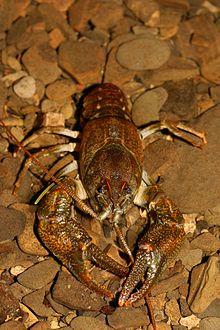Austropotamobius torrentium
| Austropotamobius torrentium | |
|---|---|

| |
| Scientific classification | |
| Domain: | Eukaryota |
| Kingdom: | Animalia |
| Phylum: | Arthropoda |
| Class: | Malacostraca |
| Order: | Decapoda |
| Suborder: | Pleocyemata |
| Family: | Astacidae |
| Genus: | Austropotamobius |
| Species: | A. torrentium
|
| Binomial name | |
| Austropotamobius torrentium (Schrank, 1803)
| |
| Subspecies[2] | |
| |
| Synonyms[3] | |
| |
Austropotamobius torrentium, also called the stone crayfish, is a
Description
A. torrentium grows to a length of around 10 centimetres (4 in), and has a smooth brown
Distribution

The distribution of A. torrentium is centred on the
In
The populations in the west of the species' range are genetically depauperate, while populations from the upper
Ecology

The preferred habitat of A. torrentium is cold, fast-flowing streams, although some live in larger rivers and lakes. It digs burrows in the banks and hides under submerged roots or rocks, emerging at night to feed.[4]
Adult A. torrentium consume a variety of plant materials, including fallen leaves, while the juveniles chiefly feed on aquatic
Beside naturally occurring threats, A. torrentium has also suffered from the introduction of the crayfish plague, Asphanomyces astaci, carried by invasive crayfish species from North America, and from the release of detergents into streams while washing laundry.[4]
Life cycle
Conservation status
A. torrentium is one of the most threatened species in Europe:
References
- ^ a b L. Füreder; F. Gherardi & C. Souty-Grosset (2010). "Austropotamobius torrentium". IUCN Red List of Threatened Species. 2010: e.T2431A121724677. Retrieved 6 January 2018.
- .
- ^ James W. Fetzner Jr. (January 14, 2008). "Austropotamobius torrentium (Schrank, 1803)". Crayfish Taxon Browser. Carnegie Museum of Natural History. Archived from the original on 2011-06-11. Retrieved 2010-02-11.
- ^ a b c d e f g h i Lucian Pârvulescu. "Austropotamobius torrentium (Schrank 1803)". Crayfish of Romania. Retrieved February 10, 2010.
- ^ Lucian Pârvulescu. "Distribution". Crayfish of Romania. Archived from the original on 28 January 2010. Retrieved February 10, 2010.
- ^ .
- .
- ^ a b Peer Martin; Matthias Pfeifer & Gert Füllner (2008). "First record of the stone crayfish Austropotamobius torrentium (Schrank, 1803) (Crustacea: Decapoda: Astacidae) from Saxony (Germany)" (PDF). Faunistische Abhandlungen. 26: 103–108.
- .
- PMID 15579394.
- ^ "Appendix III. Protected fauna species". Convention on the Conservation of European Wildlife and Natural Habitats. Council of Europe. November 19, 1979.
- ^ "Council Directive 92/43/EEC of 21 May 1992 on the conservation of natural habitats and of wild fauna and flora". European Union.

